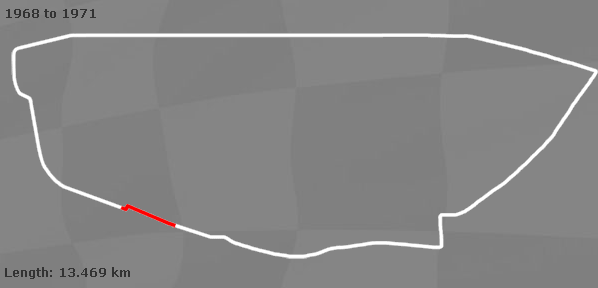The Start / Finish straight & pits
Right hand 'Arnage' corner
The circuit on which the 24 Hours of Le Mans is run is named the Circuit de la Sarthe (Circuit of the Sarthe), after the department that Le Mans is within. It consists of both permanent track and public roads that are temporarily closed for the race. Since 1923 the track has been extensively modified, mostly for safety reasons, and currently is 13.629 km (8.4 miles) in length. Although it initially entered the town of Le Mans, the track was cut short in order to better protect spectators. This led to the creation of the Dunlop Curve and Tertre Rouge corners before rejoining the old circuit on the Mulsanne. Another major change was on the Mulsanne itself, when the FIA decreed that it would no longer sanction any circuit that had a straight longer than 2 km. This led to the addition of two chicanes, reducing the time that the cars spent travelling at very high speeds on the old 6 km (3.72 miles) long straight.
If the challenge of a 24 Hour endurance race wasn't enough to motivate the competing drivers, then the fact that 75% of the circuit is taken at full throttle certainly is.
The first track layout comprised entirely of public roads to the south of the city, venturing at least half a mile into the suburbs.
The track was shortened on safety grounds to avoid the rapidly expanding town suburbs. A new link road constructed at the ACO's expense was named 'Rue du Circuit'.
The track was shortened further with a new purpose built section connecting the pits straight and the Tetre Rouge corner on the Le Mans - Tours road. This section included the erection of the famous Dunlop bridges.
In the aftermath of the terrible 1955 accident, the whole pit area was rebuilt. Track width and pit lane modifications led to a change in the Dunlop curve, shortening the track by 31 metres.
To reduce the speeds past the pit area, a chicane was installed immediately prior to the pit entrance. Named the Ford chicane, the track was slightly redirected from Maison Blanche.
Starting on the Arnage to Maison Blanche stretch, a new section was constructed, by-passing Maison Blanche completely. This joined the existing track with another slow corner at the Ford chicane.
Due to the construction of a new public road, Tertre Rouge corner had to be reprofiled, changing it from a right angled corner to a faster, but more complex double apex. Second Dunlop Bridge removed.
Mulsanne corner was modified to avoid a new roundabout that had been installed to reduce accidents at the junction. The new layout kinked right just before the original corner, with the new corner slightly offset.
Due to excessive speeds attained by the bikes on the approach to the Dunlop bridge during their races, the Dunlop curve was altered and a chicane installed before the bridge, slowing speeds dramatically.
Perhaps the most notable and unpopular changes occured in 1990, when The Mulsanne Straight was split into three sections. The addition of two mirror-imaged chicanes were introduced to comply with an FIA directive on maximum length of straights. New pit lane entrance in readiness for the new pit complex in 1991.
A slight reprofiling of the Dunlop chicane, moving the turn in further away from the bridge itself to accommodate a larger run off area/gravel trap, again mainly for the safety of the bikes.
A major change between the Dunlop Bridge & the Esses with the straight run down the hill being replaced by a series of sweeps. This was to facilitate a better entry to the short Bugatti circuit.
Reprofiling of Tertre Rouge corner, smoothing away the apex into a longer flowing curve onto the start of the Mulsanne Straight.
















